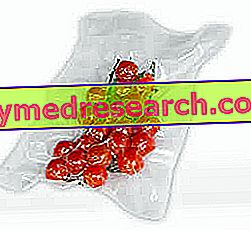What are
What are rusks?
Rusks are foods derived from cereals - especially durum wheat: Triticum aestivum .

They are traditionally used for breakfast or as a secondary snack between main meals - mid-morning and / or mid-afternoon or even before sleep.
There are various types of rusks, different in shape - round or square - taste and flavor - normal, sweet rusks, malt or cocoa rusks, etc. - and composition - traditional, wholemeal rusks, with rice or other cereals, gluten-free / gluten-free rusks, rusks without salt / low-salt etc.
Unlike ordinary bread, rusks have a completely crunchy consistency. They lend themselves to accompanying sweet and savory foods, or to being soaked.
From a nutritional point of view, compared to bread, rusks contain less water and more calories; moreover, they have a higher concentration of maltodextrins and simple / soluble sugars - also sucrose - and therefore a decidedly sweeter taste. In more restrictive diets, rusks are frequently used alone, as if they were biscuits, rather than as a substitute for bread - compared to which they have less valuable nutritional characteristics.
Rusks are mainly commercial foods; nevertheless, they can also be produced at home. Below we will propose a recipe to make them at home.
Nutritional Properties
Nutritional properties of rusks
Rusks are high energy density foods, that is very rich in calories; this characteristic is determined by the high concentration of carbohydrates, by the very low humidity and by the presence of fats - mainly unsaturated - necessary for the dough and the gilding. They also contain a modest amount of medium biological value proteins and a discrete concentration of dietary fiber.
Compared to ordinary bread, the starchy polymers and the rusk slices proteins, undergoing a double cooking, undergo thermal hydrolysis favoring the reduction of digestive times; this feature also determines an increase in the glycemic-insulin index.
Rusks contain gluten; some also show small concentrations of lactose, while the level of histamine is negligible. The purine content is low, while the phenylalanine intake appears to be of medium magnitude. Cholesterol is absent.
The rusks contain good amounts of iron - even if not very bioavailable - sodium - of table salt - potassium, magnesium and zinc. The contribution of water-soluble vitamins of group B - especially thiamine or B1, riboflavin or B2 and niacin or PP - is relevant.

| Rusks | |
| Nutritious | Quantity' |
| Edible part | 100% |
| water | 4.0 g |
| Protein | 11.3 g |
| Lipids | 6.0 g |
| Saturated fatty acids | 0.83 g |
| Monounsaturated Fatty Acids | 1.47 g |
| Polyunsaturated Fatty Acids | 2.40 g |
| Cholesterol | 4.0 mg |
| TOT Carbohydrates | 82.3 g |
| Starch / Glycogen | 72.8 g |
| Soluble Sugar | 2.2 g |
| Food fiber | 3.5 g |
| Soluble | - g |
| Insoluble | - g |
| Power | 410.0 kcal |
| Sodium | 206.0 mg |
| Potassium | 140.0 mg |
| Iron | 3.8 mg |
| Football | 55 mg |
| Phosphorus | 124.0 mg |
| Magnesium | - mg |
| Zinc | 2.0 mg |
| Copper | - mg |
| Selenium | - mcg |
| Thiamine or vitamin B1 | 0.5 mg |
| Riboflavin or vitamin B2 | 0.3 mg |
| Niacin or vitamin PP | 2.6 mg |
| Vitamin B6 | 0.10 mg |
| folate | - mcg |
| Vitamin B12 | - mcg |
| Vitamin C or Ascorbic Acid | 0.0 mg |
| Vitamin A or RAE | 0.0 RAE |
| Vitamin D | - IU |
| Vitamin K | - mcg |
| Vitamin E or Alpha Tocopherol | 1.3 mg |
Diet
Rusks in the diet
The rusks are suitable for most diets. However, due to the energy density, the glycemic load, the glycemic-insulin index more than considerable - despite being lower than those of the sweet rusks - and the unexpected presence of lipids, in the case of overweight, type 2 diabetes mellitus and Hypertriglyceridemia, it is essential not to overdo the portion and frequency of consumption.
Rusks are not a complete protein source. The biological value, of medium entity - does not contain all the essential amino acids for humans in the right quantities and proportions - requires to be compensated by taking food sources that contain the so-called limiting amino acids. Among these - not necessarily taken at the same meal - we can include all foods of animal origin, certain legumes or other seeds and seaweed. The rusks of current production have an adequate lipid profile - absence of cholesterol and prevalence of unsaturated fatty acids on the saturated, with a fraction of polyunsaturates of good entity - even for those suffering from hypercholesterolemia.
The fair amount of iron, even if not bioavailable, makes rusks a preferable food compared to many others in the same category and poorer than the mineral. However, they cannot replace elitist food sources such as meat, fish and eggs - necessary to prevent - cure iron deficiency anemia, more frequent in fertile women, in pregnant women etc. The good content of potassium and magnesium helps to cover the specific nutritional requirements of these alkalizing minerals and necessary for the transmission of the neuro-muscular action potential; in the body they decrease with increasing sweating and with fecal-urinary losses. Zinc is essential for the formation of antioxidant enzymes and to maintain the health of the thyroid. The B group vitamins play the role of coenzymes. Rusks are not an exclusive food source but participate in achieving the recommended ration, partially supporting the efficiency of all fabrics.
The rusks are not suitable for the celiac diet. If they are free of milk and derivatives, they are suitable for nutritional therapy against lactose intolerance and milk protein allergy. They can be used in the diet against hyperuricemia, histamine intolerance and phenylketonuria.
Being considered of good digestibility, rusks are sometimes recommended in the food therapy of those suffering from digestive disorders, for example: stomach acid, hiatal hernia and gastroesophageal reflux disease, gastritis and gastric or duodenal peptic ulcer.
They are all suitable for vegetarian philosophy, while only those without milk and derivatives, eggs and animal derivatives and fats lend themselves to the vegan diet. Relevance to religious diets is to be analyzed case by case, looking at the list of ingredients.
Kitchen
Rusks in the kitchen
The rusks are suitable to be covered with spreadable foods, especially sweets - honey, jam, jam, gelatin, nutella-type spreadable hazelnut cream, peanut butter, condensed milk, etc. - but also savory - robiola, crescenza, squacquerone, certosa, stracchino, ricotta, philadelphia type, anchovy paste, mayonnaise or mustard sauces etc .; it is not uncommon for them to replace slices of bread also to accompany vegetables, meat, fish, eggs, hard cheeses such as grana padano, parmigiano reggiano and pecorino, and cured meats such as prosciutto, cooked ham, salami, mortadella, the bacon, the cup, etc. - they are not suitable for collecting sauces and condiments, that is to say the note "scarpetta". They are also extremely suitable for use in milk, fruit juices and juices.
recipe
Rusks recipes
The rusks could be compared to a VERY toasted sweet bread; after the mixture, leavening and the first firing, they undergo the addition and a further heat treatment. These last passages give the rusks greater friability, lower concentrations of water, greater intake of lipids, greater energy density and greater digestibility than traditional bread.
Recipes of the commercial rusks
The ingredients of the COMMERCIAL rusks are: type 00 soft wheat flour, palm oil, brewer's yeast, sugar, barley malt extract, malted wheat flour and salt; obviously, every company has a different recipe but, in principle, the ingredients do not differ much from those mentioned - except for dietary products.
Process of commercial rusks
The process is completely automated and includes a packaging that guarantees the preservation of the organoleptic and gustatory characteristics of the rusks for a rather long period.
Recipes of homemade rusks
Rusks are foods easily reproducible even at home; the ingredients of CASALINGHE rusks are: soft wheat flour, butter, yeast, sugar, eggs, milk, water and salt (milk and eggs can be replaced by other water but the result is not superimposable).
Process of homemade rusks
The preparation takes place in the following way: sift the flours; dissolve the yeast in a little water and add it to the flour; add the rest of the water, milk, sugar and eggs, and knead; then, add the salt and softened butter, continuing to knead; let rise until it reaches twice the initial volume; break the dough by flattening the dough and rolling it up on itself; place it in a bread mold in a box lined with baking paper and let it rise again; brush with eggs or milk; bake and cook at 180 ° C for 40 '; transform it and let it cool; cut slices of about one centimeter and place them in a baking tray; bake in a fan oven at 130 ° for 45 '; leave to cool and consume.



